The Identification and Light Sensitivity of Japanese Woodblock Print ...
The Identification and Light Sensitivity of Japanese Woodblock Print ...
The Identification and Light Sensitivity of Japanese Woodblock Print ...
Create successful ePaper yourself
Turn your PDF publications into a flip-book with our unique Google optimized e-Paper software.
Connors, Page 1 <strong>of</strong> 9<br />
<strong>The</strong> <strong>Identification</strong> <strong>and</strong> <strong>Light</strong> <strong>Sensitivity</strong> <strong>of</strong> <strong>Japanese</strong> <strong>Woodblock</strong> <strong>Print</strong> Colorants:<br />
<strong>The</strong> Impact on Art History <strong>and</strong> Preservation<br />
S<strong>and</strong>ra A. Connors, Paul M. Whitmore, Roger S. Keyes <strong>and</strong> Elizabeth I. Coombs<br />
Abstract<br />
Eighty-nine eighteenth- <strong>and</strong> nineteenth-century <strong>Japanese</strong> woodblock prints from<br />
the collections <strong>of</strong> the Carnegie Museum <strong>of</strong> Art <strong>and</strong> the Library <strong>of</strong> Congress were<br />
surveyed to determine their sensitivity to visible light using a micro-fading tester<br />
developed at the Research Center on the Materials <strong>of</strong> the Artist <strong>and</strong> Conservator. When<br />
possible, the reflectance data collected by the micro-fading tester were also used to<br />
identify the natural organic colorants used on these objects. <strong>Japanese</strong> woodblock prints<br />
are considered to be light-sensitive objects, but surprisingly wide ranges <strong>of</strong> fading<br />
behavior were found. Yellow areas were created with the most light-sensitive colorants,<br />
while blue areas proved to be relatively stable to visible light. Further examination <strong>of</strong> the<br />
data showed that medium values <strong>of</strong> a colorant will fade faster than their light <strong>and</strong> dark<br />
counterparts <strong>and</strong> that the prior fading history <strong>of</strong> a colorant has little affect on its light<br />
sensitivity. <strong>The</strong> reasons for specific colorant/color use by <strong>Japanese</strong> woodblock printers<br />
are also explored.<br />
Introduction<br />
<strong>The</strong> light sensitivity <strong>of</strong> many <strong>Japanese</strong> woodblock print colorants is widely<br />
recognized, mainly from witnessing the damage that prolonged exhibition can produce.<br />
Despite this underst<strong>and</strong>ing, questions still remain about the care <strong>of</strong> these objects. <strong>The</strong><br />
light sensitivity <strong>of</strong> individual prints is not usually known, especially for those in very<br />
good states <strong>of</strong> preservation. It is also difficult to predict how much damage these prints<br />
will suffer when displayed in low-intensity, UV-free lighting environments. Many <strong>of</strong> the<br />
sensitive colorants on these objects are natural organic materials, <strong>and</strong> it is unknown<br />
whether variations in the growth, manufacture, or aging history <strong>of</strong> those materials could<br />
affect their current light sensitivity. How much <strong>of</strong> the apparent fading damage on a print<br />
is the result <strong>of</strong> light damage, or how much may be caused by other aging factors or by<br />
intentional printing <strong>of</strong> dilute colors, is also poorly understood.<br />
In the past few years, similar questions have been addressed for specific artifacts<br />
by studying them with a micro-fading tester developed at the Research Center on the<br />
Materials <strong>of</strong> the Artist <strong>and</strong> Conservator. This device allows the direct determination <strong>of</strong><br />
light sensitivity <strong>and</strong> provides information that may sometimes be used to identify the<br />
colorants present. While the main use <strong>of</strong> this instrument has been to determine the<br />
preservation needs <strong>of</strong> particular artifacts, this project is its first use to survey a group <strong>of</strong><br />
related objects—<strong>Japanese</strong> woodblock prints from the eighteenth <strong>and</strong> nineteenth century<br />
containing natural organic colorants—in order to explore the trends <strong>and</strong> variations <strong>of</strong><br />
light sensitivity for specific colors <strong>and</strong> colorants. <strong>The</strong> relative sensitivity <strong>of</strong> colorants<br />
applied at different depths <strong>of</strong> shade, <strong>and</strong> whether a colorant’s prior fading may affect its<br />
current light sensitivity, have also been explored. Further, the implications <strong>of</strong> these<br />
findings are considered from an art historical perspective by discussing the specific color<br />
<strong>and</strong> colorant choices made throughout the development <strong>of</strong> this art form.
Connors, Page 2 <strong>of</strong> 9<br />
Scope <strong>of</strong> survey <strong>and</strong> analytical methods used<br />
Eighty-nine <strong>Japanese</strong> woodblock prints were chosen for this survey, sixty-six<br />
from the James B. Austin Collection at the Carnegie Museum <strong>of</strong> Art <strong>and</strong> twenty-three<br />
from the <strong>Japanese</strong> <strong>Print</strong> Collection at the Library <strong>of</strong> Congress. <strong>The</strong> prints selected range<br />
in date from 1726–1863 <strong>and</strong> provide examples <strong>of</strong> both well-preserved <strong>and</strong> poorlypreserved<br />
color. Each color on a print was tested for sensitivity to visible light by<br />
performing in situ micro-fading tests. <strong>The</strong> instrument used has been described in detail<br />
previously (Whitmore, Pan, <strong>and</strong> Bailie 1999). Tests were performed with high-intensity<br />
visible light (400–700 nm) focused to a spot 0.4 mm in diameter. Reflectance spectra <strong>of</strong><br />
each test spot were collected during a five-minute interval <strong>and</strong> color differences (CIE ∆E<br />
values) were calculated from them using the initial spectrum as the basis for the<br />
comparison. Large values <strong>of</strong> ∆E indicate a greater measured color change in the test area.<br />
<strong>The</strong> ∆E value from each test area was compared to the ∆E values produced in Blue Wool<br />
st<strong>and</strong>ards exposed under the same conditions. <strong>The</strong> Blue Wool st<strong>and</strong>ards are designed to<br />
fade at specific rates, with Blue Wool #1 more sensitive than Blue Wool #2 <strong>and</strong> Blue<br />
Wool #2 more sensitive than Blue Wool #3. For colored materials used to make works <strong>of</strong><br />
art, fading rates comparable to Blue Wool #1–#3 are considered to be “light-sensitive.”<br />
All fading tests on the prints were performed so that the resulting color changes never<br />
exceeded five ∆E units. Such a small change in the color <strong>of</strong> the test areas is not visibly<br />
perceptible.<br />
<strong>The</strong> reflectance spectra recorded at the start <strong>of</strong> each fading test were also used to<br />
identify those natural organic colorants having characteristic spectral pr<strong>of</strong>iles. <strong>The</strong>se<br />
included dayflower blue (tsuyukusa, or aigami), indigo (ai), safflower red, <strong>and</strong> cochineal<br />
(enji), lac or madder lakes (the latter three having reflectance spectra that are nearly<br />
indistinguishable). <strong>The</strong> method for identification <strong>of</strong> these colorants using reflectance data<br />
is described elsewhere (Feller, Curran, <strong>and</strong> Bailie 1984; Leona <strong>and</strong> Winter 2001;<br />
Schweppe <strong>and</strong> Roosen-Runge 1986; Schweppe <strong>and</strong> Winter 1997). Prussian blue, a<br />
colorant used in the nineteenth century, does not have a distinctive visible reflectance<br />
spectrum, but it was identified by the absence <strong>of</strong> spectral features indicating either<br />
dayflower blue or indigo (Leona <strong>and</strong> Winter 2001).<br />
Fading test results: variations in light sensitivity among all prints<br />
Blue colorants<br />
Of the 112 blue areas tested, all but nine (which could not be identified by their<br />
reflectance spectra) were found to be one <strong>of</strong> the three blue colorants mentioned above<br />
(dayflower blue, indigo, <strong>and</strong> Prussian blue). Dayflower blue was found in one-third <strong>of</strong> the<br />
areas tested, <strong>and</strong> figure 1 shows the fading changes produced in all areas <strong>of</strong> dayflower<br />
blue, with the final ∆E values for the Blue Wool st<strong>and</strong>ards #1–#3 indicated on the right<br />
axis for reference. Dayflower blue showed fairly uniform light sensitivity, with fading<br />
rates similar to that <strong>of</strong> Blue Wool #3, making it one <strong>of</strong> the most light-stable organic<br />
colorants tested on these prints. Interestingly, the very slight color change produced<br />
during these fading tests resulted more from a loss <strong>of</strong> yellow (reflectance increase<br />
between 400–500 nm) than from a loss <strong>of</strong> blue color. Figure 2 shows the reflectance<br />
spectra for dayflower blue on a print entitled View <strong>of</strong> Ochanomizu by Hokuju in the<br />
collection <strong>of</strong> the Carnegie Museum <strong>of</strong> Art, before <strong>and</strong> after the fading test. Longer fading<br />
tests on laboratory samples showed that dayflower blue begins fading by this bleaching
Connors, Page 3 <strong>of</strong> 9<br />
<strong>of</strong> yellow color, followed by a gradual reflectance increase at all wavelengths, including<br />
those at the absorbance peaks associated with the blue color (unpublished results).<br />
Indigo was found in fewer than one-quarter <strong>of</strong> the blue areas tested <strong>and</strong> produced<br />
similar results to those found with dayflower blue. Figure 3 shows the fading results for<br />
all areas <strong>of</strong> indigo tested. <strong>The</strong> final ∆E values are grouped around that produced from the<br />
fading <strong>of</strong> Blue Wool #3, making this colorant another relatively light-stable material.<br />
Similar to dayflower blue, indigo experienced a reflectance increase in the 400–500 nm<br />
region during the fading test, rather than in the 660–700 nm region <strong>of</strong> the main indigo<br />
absorption b<strong>and</strong>.<br />
<strong>The</strong> fading tests <strong>of</strong> Prussian blue areas produced ∆E values from 0.5 to 5.4 after<br />
five minutes <strong>of</strong> exposure, which is equivalent to a range in lightfastness from Blue Wool<br />
#3 to Blue Wool #1. This result is seemingly at odds with the known light stability <strong>of</strong> this<br />
colorant (ASTM D5067-98). However, an earlier study <strong>of</strong> Prussian blue on cyanotypes<br />
(Whitmore, Bailie, <strong>and</strong> Connors 2000) showed that these fading tests cause Prussian blue<br />
(ferric ferrocyanide) to undergo the well known reversible conversion to a white<br />
compound (ferrous ferrocyanide), which converts back to the blue once the light<br />
exposure has ended. If these applications <strong>of</strong> Prussian blue behave in this typical way, then<br />
the micro-fading tests have overestimated the light sensitivity <strong>of</strong> those areas. <strong>The</strong><br />
confirmation that these fading changes are reversible would further support the<br />
identification <strong>of</strong> these passages as Prussian blue, the only available pigment known to<br />
display such behavior.<br />
Red colorants<br />
Most <strong>of</strong> the 139 red areas tested faded very slightly, showing an increase in<br />
reflectance between 400–600 nm, the main absorbance region for most red colorants.<br />
Figure 4 shows the fading test results for all red areas studied. Most <strong>of</strong> the red areas<br />
faded at rates between those <strong>of</strong> Blue Wool #2 <strong>and</strong> Blue Wool #3 <strong>and</strong> should therefore be<br />
considered moderately sensitive to visible light.<br />
Safflower red was identified on a number <strong>of</strong> prints, so the light sensitivity <strong>of</strong> these<br />
passages can be examined separately. <strong>The</strong> fading results <strong>of</strong> all the safflower red passages<br />
lie in a range only slightly narrower than that <strong>of</strong> all the red areas combined (see figure 5),<br />
with fading rates between Blue Wool #3 <strong>and</strong> halfway between Blue Wool #2 <strong>and</strong> Blue<br />
Wool #3.<br />
<strong>The</strong> three-peak absorbance pattern typical <strong>of</strong> cochineal, lac <strong>and</strong> madder lakes was<br />
found on two <strong>of</strong> the prints studied. <strong>The</strong> fading rates in these areas were found to be<br />
comparable to that <strong>of</strong> Blue Wool #3.<br />
Purple colorants<br />
Figure 6 shows the fading results for all purple areas tested. A relatively narrow<br />
range <strong>of</strong> fading behavior centered around Blue Wool #3 was found, with the exception <strong>of</strong><br />
two purple areas showing faster fading rates (around Blue Wool #2).<br />
<strong>The</strong> literature describes overprinting or mixtures <strong>of</strong> blue <strong>and</strong> red colorants being<br />
used to create purple areas <strong>of</strong> color (Keyes 1988; Feller, Curran, <strong>and</strong> Bailie 1984). Just<br />
under half <strong>of</strong> the sixty-six purple areas studied showed spectral features typical <strong>of</strong><br />
dayflower blue <strong>and</strong> safflower red, while only six areas showed the spectral characteristics
Connors, Page 4 <strong>of</strong> 9<br />
<strong>of</strong> indigo <strong>and</strong> safflower red. <strong>The</strong> composition <strong>of</strong> the remaining purple passages could not<br />
be determined from their reflectance spectra. In the mixtures <strong>of</strong> safflower red <strong>and</strong><br />
dayflower blue, the more fugitive colorant seems to be safflower red. This is consistent<br />
with the observed greater light sensitivity <strong>of</strong> safflower red compared to dayflower blue<br />
measured in the passages <strong>of</strong> unmixed color. Figure 7 shows a difference spectrum<br />
describing the spectral changes produced during the fading <strong>of</strong> the purple area on Actor as<br />
Kintoki Hanhyôe by Kunisada, in the collection at the Carnegie Museum <strong>of</strong> Art. <strong>The</strong><br />
greatest increase in reflectance occurred around 540 nm, the absorbance peak for<br />
safflower red, indicating that the light exposure caused predominantly the destruction <strong>of</strong><br />
the safflower red in the purple mixture.<br />
<strong>The</strong> two purple areas showing the remarkably fast fading were also mixtures <strong>of</strong><br />
safflower red <strong>and</strong> dayflower blue on two prints from an untitled set <strong>of</strong> Eight Views <strong>of</strong> Edo<br />
by Hidemaro, in the collection at the Carnegie Museum <strong>of</strong> Art. Like the typical<br />
safflower–dayflower purple mixtures described in figure 7, these also faded mainly by<br />
loss <strong>of</strong> the safflower red from the mixture. On these two prints, however, the safflower<br />
red faded more rapidly from the purple mixture than was observed in the fading tests <strong>of</strong><br />
the unmixed safflower red areas on these prints. <strong>The</strong> reason for this finding is not known,<br />
but it suggests that a different safflower red could have been used for the purple mixture<br />
than was used for the applications <strong>of</strong> unmixed colorant in the red passages. It should also<br />
be noted that there were only a few eighteenth-century prints in this study that included<br />
well preserved purple areas. Early methods <strong>of</strong> preparing safflower red or <strong>of</strong> printing<br />
purple may have resulted in these unusually light sensitive mixtures.<br />
Green colorants<br />
Various green passages were studied, ranging in hue from yellow-green to bluegreen.<br />
Figure 8 shows the fading results from all eighty-two green areas tested. <strong>The</strong> range<br />
<strong>of</strong> fading behavior is wider than that seen for either red or blue colorants, with ∆E values<br />
between 0.1 <strong>and</strong> 4.4 after five minutes <strong>of</strong> exposure. <strong>The</strong> majority <strong>of</strong> green areas showed<br />
fading rates near Blue Wool #3, but some areas faded at rates near Blue Wool #2,<br />
indicating their greater light-sensitivity. <strong>The</strong> color change that occurred during the fading<br />
<strong>of</strong> most <strong>of</strong> these green passages was a loss <strong>of</strong> yellow. Figure 9 shows the difference<br />
spectrum after the fading <strong>of</strong> a green area on Actor as Oguri Hangan by Kunisada, in the<br />
Collection at the Carnegie Museum <strong>of</strong> Art. <strong>The</strong> greatest change was produced between<br />
400–500 nm, indicating fading <strong>of</strong> a yellow component in a mixture. While dayflower<br />
blue <strong>and</strong> indigo also showed a reflectance increase between 400–500 nm during the<br />
fading tests, the increase experienced by a mixture <strong>of</strong> yellow with either <strong>of</strong> these blue<br />
colorants was greater than that experienced by the blue colorant alone.<br />
Green passages were typically created using yellow-blue colorant mixtures, by<br />
overprinting yellow <strong>and</strong> blue colorants, or by using the green mineral pigment malachite<br />
(Keyes 1988; Feller, Curran, <strong>and</strong> Bailie 1984). Half <strong>of</strong> the green areas studied showed<br />
reflectance spectra indicating the presence <strong>of</strong> indigo, while only one print contained<br />
green passages created from a mixture <strong>of</strong> dayflower blue <strong>and</strong> a yellow colorant. <strong>The</strong><br />
composition <strong>of</strong> the remaining green passages could not be identified because <strong>of</strong> the lack<br />
<strong>of</strong> distinctive features in their reflectance spectra.
Connors, Page 5 <strong>of</strong> 9<br />
Yellow colorants<br />
<strong>The</strong> yellow areas studied showed the widest range <strong>of</strong> fading behavior <strong>of</strong> any color<br />
category. Figure 10 shows the fading results observed in all yellow areas studied. <strong>The</strong><br />
light sensitivity <strong>of</strong> these colorants ranged from relatively light-stable areas, with fading<br />
rates less than that <strong>of</strong> Blue Wool #3, to very fugitive areas, with fading rates greater than<br />
that <strong>of</strong> Blue Wool #2. <strong>The</strong> yellows were frequently the most light-sensitive colors on a<br />
given print.<br />
A variety <strong>of</strong> organic <strong>and</strong> inorganic yellow colorants was available for use on<br />
<strong>Japanese</strong> woodblock prints (Keyes 1988; Feller, Curran, <strong>and</strong> Bailie 1984), <strong>and</strong> distinction<br />
between these colorants is difficult because <strong>of</strong> the lack <strong>of</strong> characteristic features in their<br />
visible reflectance spectra. However, several <strong>of</strong> the yellow areas tested showed unusual<br />
fading behavior that could be distinctive. For example, some areas darkened (experienced<br />
a decrease in reflectance) as a result <strong>of</strong> light exposure. Exploring whether such a light<br />
reaction can be used to identify yellow colorants is an area for future research.<br />
<strong>Light</strong> sensitivity for different concentrations <strong>of</strong> the same colorant<br />
In order to produce a variety <strong>of</strong> shades for a particular color, colorants were <strong>of</strong>ten<br />
used in different concentrations, were overprinted, or were applied as gradations <strong>of</strong> color<br />
during the printing. <strong>The</strong> Great Bridge at Senju by Hiroshige, in the collection at the<br />
Library <strong>of</strong> Congress, exhibits a gradation from medium to light shades <strong>of</strong> safflower red<br />
along the horizon, <strong>and</strong> a dark shade <strong>of</strong> safflower red was used for the cartouche in the<br />
upper right corner <strong>of</strong> the print. When tested, each <strong>of</strong> these areas showed different light<br />
sensitivities. Figure 11 shows the fading results for dark, medium, <strong>and</strong> light applications<br />
<strong>of</strong> safflower red on <strong>The</strong> Great Bridge at Senju. Greater fading was observed for the<br />
medium-value safflower red area compared to either the very light or very dark areas.<br />
This is consistent with the fading behavior observed in light, medium, <strong>and</strong> dark paint<br />
glazes, where the greater sensitivity <strong>of</strong> the medium-value paints is well known<br />
(Whitmore <strong>and</strong> Bailie 1997).<br />
Fading behavior <strong>of</strong> well preserved <strong>and</strong> poorly preserved prints<br />
<strong>The</strong>se results can also be examined to determine whether prior fading <strong>of</strong> a print<br />
has any effect on the current light sensitivity <strong>of</strong> its colorants. Equivalent shades<br />
(reflectance minimum around forty percent) <strong>of</strong> safflower red were compared from <strong>The</strong><br />
Courtesan Miyoharu with Child Attendants by Kiyomine (a print with well preserved<br />
color) <strong>and</strong> <strong>The</strong> Actors Sanogawa Ichimatsu <strong>and</strong> Ôtani Oniji by Masanobu (a print with<br />
poorly preserved color), both in the collection at the Carnegie Museum <strong>of</strong> Art. <strong>The</strong> fading<br />
results for the areas tested are seen in figure 12, where it can be seen that the well<br />
preserved <strong>and</strong> previously faded areas <strong>of</strong> safflower red have essentially the same light<br />
sensitivity. This suggests that safflower red is probably not composed <strong>of</strong> a mixture <strong>of</strong><br />
components <strong>of</strong> varying lightfastness. This finding may also explain why the various<br />
safflower red passages on all the prints had reasonably similar light sensitivity. While this<br />
behavior has not been tested with other colorants because <strong>of</strong> a lack <strong>of</strong> suitable prints for<br />
comparison, one may reasonably expect that the other colorants found in this survey are<br />
similarly homogeneous because they also tended to have relatively constant light<br />
sensitivity among the prints in this group.
Connors, Page 6 <strong>of</strong> 9<br />
Art historical implications<br />
Let us now consider this data from a historical perspective. <strong>The</strong> earliest print in<br />
this study is a h<strong>and</strong>-colored picture <strong>of</strong> kabuki actors by Toshinobu that was published in<br />
the 1720s (see figure 13). <strong>Print</strong> artists <strong>of</strong>ten combined colors in characteristic ways to<br />
produce particular effects. <strong>The</strong> colorist here emphasized the three primary colors, red,<br />
yellow, <strong>and</strong> blue, to produce a lively effect by contrast <strong>of</strong> hue. When <strong>Japanese</strong> craftsmen<br />
developed techniques <strong>of</strong> color printing in the middle <strong>of</strong> the eighteenth century many<br />
favored the same palette <strong>of</strong> three primary colors that predominate the earlier print, as in<br />
the Kiyomitsu actor portrait from the early 1760s seen in figure 14. One important result<br />
<strong>of</strong> this study is the discovery that beni, or safflower, produces most <strong>of</strong> the common reds<br />
in eighteenth- <strong>and</strong> early nineteenth-century prints <strong>and</strong> that dayflower, or tsuyukusa,<br />
produces nearly all the blue <strong>and</strong> gray-blue colors in these prints. This is a surprising<br />
limitation considering that other red <strong>and</strong> blue colorants were available <strong>and</strong> occasionally<br />
used on prints. All three primary colors are moderately light sensitive, but we should not<br />
assume that light hues <strong>of</strong> organic colorants on <strong>Japanese</strong> prints are always the result <strong>of</strong><br />
fading because printers <strong>of</strong>ten diluted the colorants. This was typical <strong>of</strong> inexpensive color<br />
prints <strong>of</strong> the period, <strong>and</strong> may have been a cost-cutting measure.<br />
Later artists continued to produce prints using this same color contrast. Figure 15<br />
shows the unfaded courtesan portrait by Kiyomine, which was published in 1805 or 1806.<br />
<strong>The</strong> printer has added some green, but the main colors are still red, blue, <strong>and</strong> yellow, a<br />
combination now associated with inexpensive color prints. Patronage allowed artists to<br />
experiment with color <strong>and</strong> encouraged printers to introduce new colorants. Suzuki<br />
Harunobu’s Night Rain on the Kettle (figure 16) published in 1766 is clearly much more<br />
colorful <strong>and</strong> complex than Kiyomitsu’s simple three-color print.<br />
Commercial two-color printing developed in the city <strong>of</strong> Edo in the mid-1740s,<br />
<strong>and</strong> for over a decade the two colors <strong>of</strong> choice were green <strong>and</strong> red, as in the actor portrait<br />
by Okumura Masanobu in figure 17. This palette achieved its effect by the contrast <strong>of</strong> the<br />
cool green with the warm red. Another <strong>of</strong> the surprising results <strong>of</strong> this study is the<br />
discovery that virtually all the greens in eighteenth-century prints are mixtures <strong>of</strong> indigo<br />
blue with yellow. Many hues <strong>of</strong> green appear on the prints, as in the picture by Shunchô<br />
from the late 1780s (see figure 18). It seems likely that this variation results from mixing<br />
the indigo blue with different yellows that could not be identified in this study. It is all the<br />
more surprising that indigo was so rarely used as a print colorant in its own right during<br />
this period. <strong>The</strong> study found indigo as blue on only one eighteenth-century print. By<br />
contrast, the print in figure 19 by Shunshô <strong>of</strong> around 1780 contains an uncommon<br />
yellowish green produced by mixing dayflower blue with yellow.<br />
<strong>The</strong> unfaded 1798 actor portrait by Toyokuni, in figure 20, is an excellent<br />
example <strong>of</strong> dayflower blue, safflower red, <strong>and</strong> one <strong>of</strong> the purples that is produced by<br />
mixing them. Dayflower was a versatile color, <strong>and</strong> the dilute blue here looks like a warm<br />
gray, in deliberate contrast to the cooler dilute sumi gray <strong>of</strong> the background.<br />
A dramatic change occurred in the late 1820s when imported Prussian blue<br />
became more readily available to printers. <strong>The</strong> vivid, intense blues in this Yoshitoshi<br />
print published in 1863 (see figure 21) are Prussian blue, <strong>and</strong> it is easy to underst<strong>and</strong> its<br />
appeal <strong>and</strong> to underst<strong>and</strong> why it swiftly replaced both dayflower <strong>and</strong> indigo. Unlike<br />
dayflower, it was also stable in the presence <strong>of</strong> moisture. <strong>The</strong> current study was not able<br />
to confirm the presence <strong>of</strong> Prussian blue in mixtures because <strong>of</strong> its lack <strong>of</strong> characteristic
Connors, Page 7 <strong>of</strong> 9<br />
spectral features, but Prussian blue easily mixed with available reds <strong>and</strong> yellows <strong>and</strong> may<br />
be responsible for a variety <strong>of</strong> greens <strong>and</strong> purples on mid <strong>and</strong> late nineteenth-century<br />
prints. This is an area that must be explored in future research.<br />
This study shows that many <strong>Japanese</strong> print artists, like Eishi in the 1790s (figure<br />
22) <strong>and</strong> Hokusai in the 1830s (figure 23), <strong>of</strong>ten used a very limited range <strong>of</strong> familiar<br />
colorants. No doubt publishers had an economic incentive to minimize their capital<br />
outlay by limiting the number <strong>of</strong> blocks in a given print <strong>and</strong> restricting the colorants.<br />
Audiences during certain periods also seem to have been conservative in their taste,<br />
preferring familiar color combinations. <strong>The</strong> artists satisfied both groups by producing<br />
both extremely bold <strong>and</strong> extremely subtle effects with a very limited range <strong>of</strong> colorants.<br />
Of course, tastes changed, <strong>and</strong> private patronage was one force behind these changes. In<br />
1822, Hokusai designed a privately commissioned series <strong>of</strong> thirty prints including this<br />
one for a group <strong>of</strong> poets, utilizing indigo as blue <strong>and</strong> metallic powders (figure 24). <strong>The</strong><br />
designers <strong>of</strong> surimono, as these prints are called, pioneered the use <strong>of</strong> highly saturated<br />
colors <strong>and</strong> other printing effects that became prevalent in commercial prints <strong>of</strong> the mid-<br />
1840s, like the fan print by Sadahide (figure 25). This study indicates, however, that<br />
commercial publishers at the end <strong>of</strong> this long tradition <strong>of</strong> color printing still encouraged<br />
artists to limit their palettes to readily available colorants, although the printers’<br />
increasing skills produced an ever-widening range <strong>of</strong> color mixtures, color contrasts <strong>and</strong><br />
special visual effects.<br />
Conclusions<br />
This study successfully used a micro-fading tester to evaluate eighty-nine<br />
<strong>Japanese</strong> woodblock prints. <strong>The</strong> results give a good prediction <strong>of</strong> visible light sensitivity<br />
when compared to the Blue Wool st<strong>and</strong>ards used for reference <strong>and</strong> will therefore be<br />
useful for the future exhibition <strong>of</strong> these prints. <strong>The</strong> light source used for these tests,<br />
however, is not likely to be the same light source used for museum exhibition conditions.<br />
To further underst<strong>and</strong> how such prints will react to specific lighting conditions the Blue<br />
Wool reference strips can be used.<br />
<strong>The</strong> natural organic colorants on these prints exhibited a range <strong>of</strong> light sensitivity.<br />
<strong>The</strong> fading rates <strong>of</strong> most <strong>of</strong> the areas tested were between Blue Wool #3 <strong>and</strong> Blue Wool<br />
#2. For the five color categories tested, the colors ranked from relatively stable (fading<br />
rates slower than Blue Wool #3) to fugitive (fading rates faster than Blue Wool #2) in the<br />
following way: blue < red < purple < green < yellow. <strong>The</strong> result that blue colorants are<br />
the most stable is somewhat surprising because at least one blue colorant, dayflower blue,<br />
was previously thought to be extremely light-sensitive, a perception arising from the<br />
observation <strong>of</strong> apparent fading damage to dayflower areas. <strong>The</strong> findings <strong>of</strong> this study<br />
suggest that the “damage” to dayflower blue passages may not have been caused by<br />
visible light exposure. Exposure to ultraviolet light (which will be limited in future<br />
museum exhibition) or other aging processes besides light fading may be to blame.<br />
Exploration into some <strong>of</strong> these factors is an area for future research.<br />
Further examination <strong>of</strong> the data showed that medium shades <strong>of</strong> a colorant had<br />
faster rates <strong>of</strong> fading compared to light <strong>and</strong> dark areas <strong>of</strong> the same colorant. It is<br />
important to note that dark shades may experience an increase in their rate <strong>of</strong> appearance<br />
change over time as they fade towards these medium shades. <strong>The</strong>refore, the results <strong>of</strong>
Connors, Page 8 <strong>of</strong> 9<br />
light-sensitivity testing should be considered an evaluation <strong>of</strong> a dark color’s current<br />
stability <strong>and</strong> should not be extrapolated to light exposure doses greater than those used in<br />
the test.<br />
It was also shown that the prior fading history <strong>of</strong> a print does not seem to affect<br />
the light sensitivity <strong>of</strong> safflower red. This suggests that safflower red (or the natural<br />
organic materials that make up safflower red) is not a mixture <strong>of</strong> materials with different<br />
light sensitivities. Instead, the color is produced by a single colorant or colorants with<br />
very similar light sensitivities. <strong>The</strong>refore, faded areas <strong>of</strong> color will not achieve greater<br />
light stability from loss <strong>of</strong> a light sensitive component.<br />
<strong>The</strong> tests performed during this study do give a good prediction <strong>of</strong> a color’s light<br />
sensitivity; however, they do not indicate how much color change has already occurred.<br />
Curators, conservators, <strong>and</strong> scholars should be cautious in their assessment <strong>of</strong> color on<br />
traditional <strong>Japanese</strong> prints. Many colors become paler as they fade, but some printers<br />
intentionally dilute colors, so pale prints are not necessarily faded, although this is <strong>of</strong>ten<br />
the case.<br />
Acknowledgements<br />
Experimental work was performed at the Carnegie Museum <strong>of</strong> Art <strong>and</strong> the<br />
Library <strong>of</strong> Congress <strong>and</strong> was supported by grants from the Andrew W. Mellon<br />
Foundation <strong>and</strong> the United States Japan Foundation. <strong>The</strong> authors would like to thank<br />
Shiho Sasaki for many informative discussions regarding <strong>Japanese</strong> colorants <strong>and</strong> for<br />
preparation <strong>of</strong> dayflower blue samples used in laboratory analysis. This work would not<br />
have been possible without the assistance <strong>and</strong> consultation <strong>of</strong> Linda Batis <strong>and</strong> Ellen<br />
Baxter from the Carnegie Museum <strong>of</strong> Art. <strong>The</strong> twenty-three prints from the Library <strong>of</strong><br />
Congress were chosen in consultation with Library staff Linda Stiber Morenus, Senior<br />
Paper Conservator; Katherine Blood, Curator for Fine <strong>Print</strong>s; <strong>and</strong> Betty Fiske, contract<br />
paper conservator specializing in <strong>Japanese</strong> prints. <strong>The</strong> materials selected by this team for<br />
study were representative <strong>of</strong> a historical cross-section <strong>of</strong> the Library’s <strong>Japanese</strong> print<br />
collection, dating from the early eighteenth century through the nineteenth century. <strong>The</strong><br />
authors would also like to Dianne van der Reyden, Maria Nugent, Jeremy Adamson, <strong>and</strong><br />
Harry Katz from the Library <strong>of</strong> Congress for their contribution to this project.<br />
References<br />
American Society for Testing <strong>and</strong> Materials. 1999. ASTM D5067-98, st<strong>and</strong>ard for artists’<br />
oil, resin-oil <strong>and</strong> alkyd paints. In 1999 Annual Book <strong>of</strong> ASTM St<strong>and</strong>ards: Paints, Related<br />
Coatings <strong>and</strong> Aromatics, ed. R. Allen, et al., 442-447. West Conshohocken: American<br />
Society for Testing <strong>and</strong> Materials.<br />
Feller R., M. Curran, <strong>and</strong> C. Bailie. 1984. <strong>Identification</strong> <strong>of</strong> traditional organic colorants<br />
employed in <strong>Japanese</strong> prints <strong>and</strong> determination <strong>of</strong> their rates <strong>of</strong> fading. In <strong>Japanese</strong><br />
<strong>Woodblock</strong> <strong>Print</strong>s: A Catalogue <strong>of</strong> the Mary A. Ainsworth Collection, ed. R. Keyes., 253-<br />
266. Oberlin: Oberlin College.<br />
Keyes, K. 1988. <strong>Japanese</strong> print conservation – an overview. In <strong>The</strong> Conservation <strong>of</strong> Far<br />
Eastern Art, ed. J. Mills, P. Smith, <strong>and</strong> K. Yamasaki, 30-36. London: IIC.
Connors, Page 9 <strong>of</strong> 9<br />
Leona, M., <strong>and</strong> J. Winter. 2001. Fiber optics reflectance spectroscopy: a unique tool for<br />
the investigation <strong>of</strong> <strong>Japanese</strong> paintings. Studies in Conservation 46:153-162.<br />
Schweppe, H., <strong>and</strong> H. Roosen-Runge. 1986. Carmine – cochineal carmine <strong>and</strong> kermes<br />
carmine. In Artists’ Pigments: A H<strong>and</strong>book <strong>of</strong> their History <strong>and</strong> Characteristics, vol. 1,<br />
ed. R. Feller, 255-283. Washington: National Gallery <strong>of</strong> Art.<br />
Schweppe, H., <strong>and</strong> J. Winter. 1997. Madder <strong>and</strong> Alizarin. In Artists’ Pigments: A<br />
H<strong>and</strong>book <strong>of</strong> their History <strong>and</strong> Characteristics, vol. 3, ed. E. W. Fitzhugh, 109-142.<br />
Washington: National Gallery <strong>of</strong> Art.<br />
Whitmore, P., <strong>and</strong> C. Bailie. 1997. Further studies on transparent glaze fading: chemical<br />
<strong>and</strong> appearance kinetics. Journal <strong>of</strong> the American Institute for Conservation 36:207-230.<br />
Whitmore, P., X. Pan, <strong>and</strong> C. Bailie. 1999. Predicting the fading <strong>of</strong> objects: <strong>Identification</strong><br />
<strong>of</strong> fugitive colorants through direct nondestructive lightfastness measurements. Journal <strong>of</strong><br />
the American Institute for Conservation 38:395-409.<br />
Whitmore, P., C. Bailie, <strong>and</strong> S. Connors. 2000. Micro-Fading to Predict the Result <strong>of</strong><br />
Exhibition: Progress <strong>and</strong> Prospects. In Tradition <strong>and</strong> Innovation: Advances in<br />
Conservation, ed. A. Roy <strong>and</strong> P. Smith, 200-205. London: IIC.



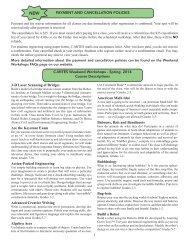

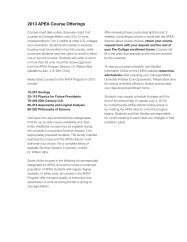

![Pittsburgh Neighborhoods [.pdf] - Carnegie Mellon University](https://img.yumpu.com/22011290/1/190x115/pittsburgh-neighborhoods-pdf-carnegie-mellon-university.jpg?quality=85)
![Curriculum Vitae [.pdf] - Carnegie Mellon University](https://img.yumpu.com/20737100/1/190x245/curriculum-vitae-pdf-carnegie-mellon-university.jpg?quality=85)
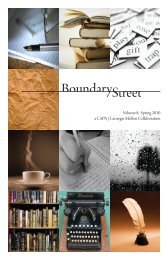
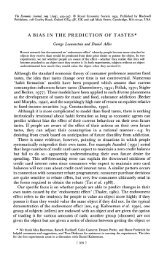


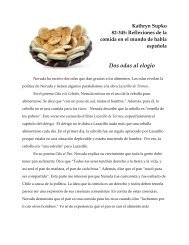


![May 2012 [.pdf] - Carnegie Mellon University](https://img.yumpu.com/12198417/1/190x253/may-2012-pdf-carnegie-mellon-university.jpg?quality=85)
